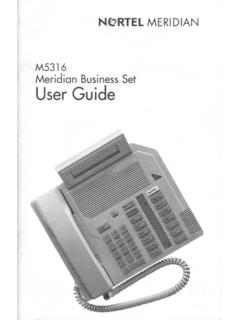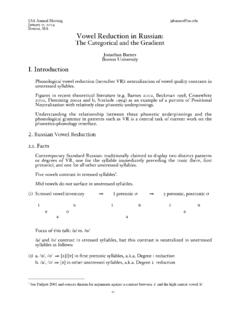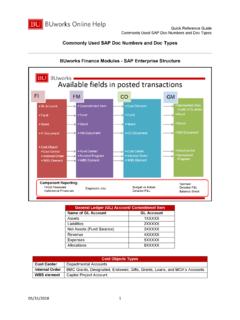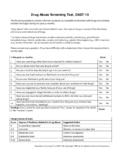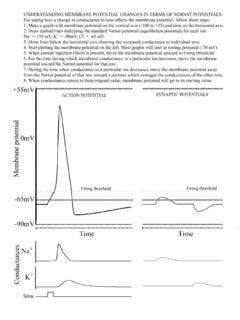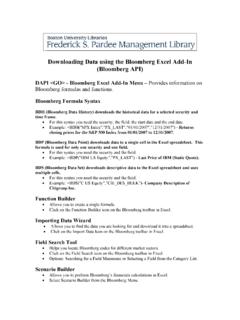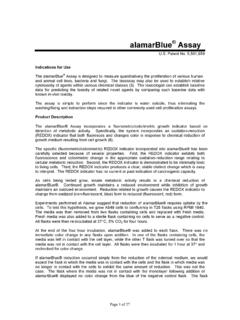Transcription of Introduction to Flow Cytometry
1 Introduction toFlow Cytometry : A Learning Guide 11-11032-03 rev. ADecember 2002 Introduction to Flow Cytometry : A Learning Guide Copyright 2002 Becton, Dickinson and Company. All rights reserved. No part of this publication may be reproduced, transmitted, transcribed, stored in retrieval systems, or translated into any language or computer language, in any form or by any means: electronic, mechanical, magnetic, optical, chemical, manual, or otherwise, without the prior written permission of BD Biosciences, 2350 Qume Drive, San Jose, CA 95131, United States of America. Disclaimer BD Biosciences reserves the right to change its products and services at any time to incorporate the latest technological developments.
2 This guide is subject to change without notice. BD Biosciences welcomes customer input on corrections and suggestions for this guide has been prepared with every precaution to ensure accuracy, BD Biosciences assumes no liability for any errors or omissions, nor for any damages resulting from the application or use of this information. Trademarks Apple, the Apple logo, Mac, Macintosh, and Power Macintosh are trademarks of Apple Computer, Inc., registered in the and other countries. Finder is a trademark of Apple Computer, LT and QuantiCALC are trademarks of Verity Software House, Attractors, BD CellQuest, BD FACS, BD FACSC alibur, BD FACSDiVa, BD FACScan, BD FACSort, BD FACSV antage, BD FACSV antage SE, BD MultiSET, are trademarks of Becton, Dickinson and Company.
3 Iii Introduction to Flow Cytometry : A Learning Guide Table of Contents Preface .. v For More Information .. vChapter 1 Overview .. 1 Review Questions: Overview .. 3 Chapter 2 Fluidics .. 5 Review Questions: Fluidics .. 8 Chapter 3 Generation of Scatter and Fluorescence .. Light Scatter .. 10 Review Questions: Light Scatter .. 12 Fluorescence .. 13 Review Questions: Fluorescence .. 15 Chapter 4 Optical System .. Optical Bench .. 17 Review Questions: Optical Bench .. 19 Optical Filters .. 20 Review Questions: Optical Filters .. 21 Signal Detection .. 22 Review Questions: Signal Detection .. 24 Threshold .. 25 Review Questions: Threshold .. 25 Chapter 5 Data Analysis.
4 Data Collection and Display .. 27 Review Questions: Data Collection and Display .. 28 Gating .. 29 Review Questions: Gating .. 29 Data Analysis for Subsetting Applications .. Data Analysis for Other Applications .. 34 Review Questions: Data Analysis .. 36 iv Introduction to Flow Cytometry : A Learning Guide Chapter 6 Sorting .. Sorting .. 39 Review Questions: Sorting .. 41 Chapter 7 Lasers and Alignment .. How Lasers Work .. 43 Laser Alignment .. 44 Review Questions: Lasers and Alignment .. 45 Answer Key .. 47 Review Questions: Overview on page 3 .. 47 Review Questions: Fluidics on page 8 .. 48 Review Questions: Light Scatter on page 12 .. 48 Review Questions: Fluorescence on page 15.
5 49 Review Questions: Optical Bench on page 19 .. 49 Review Questions: Optical Filters on page 21 .. 49 Review Questions: Signal Detection on page 24 .. 50 Review Questions: Threshold on page 25 .. 50 Review Questions: Data Collection and Display on page 28 .. 50 Review Questions: Gating on page 29 .. 50 Review Questions: Data Analysis on page 36 .. 51 Review Questions: Sorting on page 41 .. 51 Review Questions: Lasers and Alignment on page 45 .. 52 v Preface Learning to operate a flow cytometer is best achieved by using the instrument. However, understanding the principles underlying this technology greatly facilitates the document contains basic information on flow Cytometry . Differences between flow cell based benchtop cytometers (BD FACScan , BD FACSort , BD FACSC alibur , and BD LSR cytometers) and stream-in-air cytometers (BD FACS Vantage and BD FACSV antage SE cytometers) are described in relevant sections.
6 Reading this material and answering the questions at the end of each section will enhance your hands-on training experience during Operator Training at BD Biosciences. This assignment will take approximately hours to complete. Please review it before you attend the training session. An answer key is provided. If you have any questions or problems in the US, call , prompts 2, 2. In Europe or Canada, contact your local application specialist. For More Information For more information on general flow Cytometry , review the following: Givan AL. Flow Cytometry : First Principles . New York, NY: Wiley-Liss; 2001 (ISBN 0-471-38224-8). Melamed MR. Flow Cytometry and Sorting . New York, NY: Wiley-Liss; 1990 (ISBN 0-471-56235-1).
7 Shapiro H. Practical Flow Cytometry . 3rd ed. New York, NY: Alan R. Liss; 1995 (ISBN 0-471-30376-3). Introduction to Flow Cytometry : A Learning Guide vi 1 1 Overview Flow Cytometry is a technology that simultaneously measures and then analyzes multiple physical characteristics of single particles, usually cells, as they flow in a fluid stream through a beam of light. The properties measured include a particle s relative size, relative granularity or internal complexity, and relative fluorescence intensity. These characteristics are determined using an optical-to-electronic coupling system that records how the cell or particle scatters incident laser light and emits flow cytometer is made up of three main systems: fluidics, optics, and electronics.
8 The fluidics system transports particles in a stream to the laser beam for interrogation. The optics system consists of lasers to illuminate the particles in the sample stream and optical filters to direct the resulting light signals to the appropriate detectors. The electronics system converts the detected light signals into electronic signals that can be processed by the computer. For some instruments equipped with a sorting feature, the electronics system is also capable of initiating sorting decisions to charge and deflect the flow cytometer, particles are carried to the laser intercept in a fluid stream. Any suspended particle or cell from 150 micrometers in size is suitable for analysis.
9 Cells from solid tissue must be desegregated before analysis. The portion of the fluid stream where particles are located is called the sample core. When particles pass through the laser intercept, they scatter laser light. Any fluorescent molecules present Introduction to Flow Cytometry : A Learning Guide 2 on the particle fluoresce. The scattered and fluorescent light is collected by appropriately positioned lenses. A combination of beam splitters and filters steers the scattered and fluorescent light to the appropriate detectors. The detectors produce electronic signals proportional to the optical signals striking mode data are collected on each particle or event. The characteristics or parameters of each event are based on its light scattering and fluorescent properties.
10 The data are collected and stored in the computer. This data can be analyzed to provide information about subpopulations within the sample (Figure1-1). Figure1-1 Scattered and emitted light signals converted to electronic pulseslasersample coredata displayselectronic pulses Chapter : Overview 3 Review Questions: Overview 1 What properties of a cell or particle can be measured by a flow cytometer? 2 What light source is used in most flow cytometers? 3 What are the three main systems in a flow cytometer? 4 What type of biological sample is best suited for flow cytometric analysis? 5 What is the name given to the portion of the fluid stream where the cells are located? 6 When cells labeled with fluorescent molecules pass through the focused laser beam, what two types of light signals are generated?
